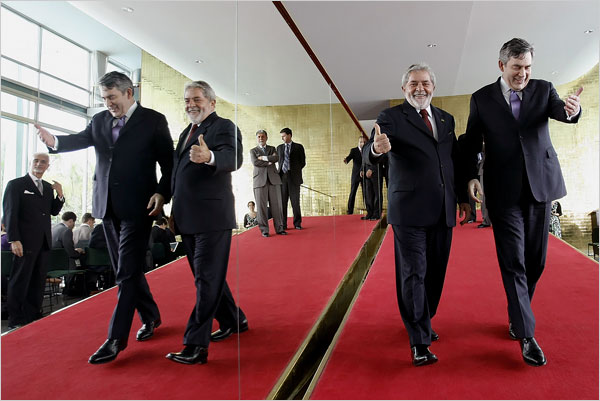Both academic and public discussion of photojournalism is fraught with anxiety about the danger of images displacing realty. Writers such as Daniel Boorstin and Susan Sontag have issued dire warnings about the moral and political decline that is sure to occur as visual media create a world of pseudo-events, manufactured experiences, and the cult of celebrity. When you look at a photograph like the one below, you might think the critics have a point.
As the Prime Ministers of Great Britain and Brazil walk toward the camera, their mirror images are captured alongside them. The photograph depicts its own ability to create an image out of reality, while also hiding the slight of hand by which it appears to us as the real thing. Thus, we look at the photograph and see the figures on the right as the real Prime Ministers–in contrast to their images on the left–but, of course, the figures on the right are images, not the PMs themselves who now probably are continents apart. In short, the photo makes one think that it is the equivalent of the real, when it is actually is an illusion taking the place of reality.
Not that this bothers the ministers. They are having a fine time together; indeed, they look like two seasoned troupers hitting the stage for an encore. A politics of photo-ops for stage-managed pseudo-events (like the G20 meeting that was the pretext for this picture) doesn’t bother them. Their attention to political performance is captured by every aspect of the photo, including the elocutionary behavior (bodies entrained in conventional costumes, postures, smiles, and gestures directed toward an audience), the stage created by the raised walkway, red carpet, and supernumeraries, and the mirror’s duplication of the actors, which throws them into an aesthetic space for depicting social reality.
But wait a minute. If the mirror highlights performance to reveal social habits, it might be exposing illusions rather than creating them. Isn’t the primary illusion in the political performance itself, not in the photograph? Or could it be that real Prime Ministers still have to act like Prime Ministers, and that this photograph captures that relatively complex relationship between image and reality. Likewise, featuring the mirror might be one way that the photograph is encouraging reflexive consideration of the transformations between image and reality in the public media, including photojournalism, rather than suppressing such awareness.
If you want to see reality in a world of images, sometimes it might be enough to hold up a mirror.
Photograph by Evaristo Sa/AFP-Getty Images.

The two PMs, in the way of Important Politicians and Major Actors, are hogging the spotlight. In the mirror, however, we can see other players, none of whom appears to be particularly involved with, interested in, or even aware of the Top Bananas.
[…] Monday I posted on a photographer’s use of a mirror to help the viewer think about the political spectacle. […]